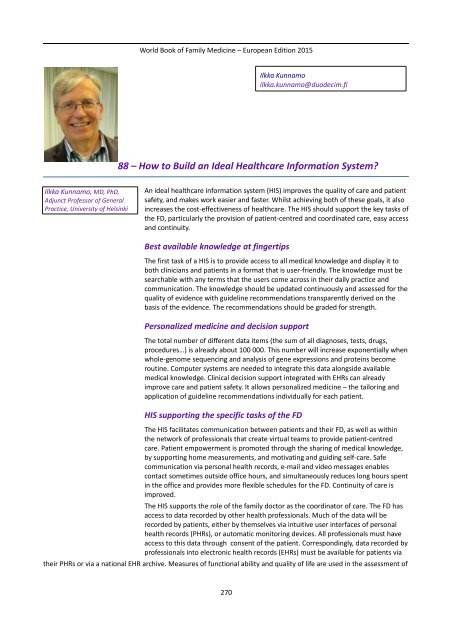Family Medicine
World Book 2015
World Book 2015
You also want an ePaper? Increase the reach of your titles
YUMPU automatically turns print PDFs into web optimized ePapers that Google loves.
World Book of <strong>Family</strong> <strong>Medicine</strong> – European Edition 2015<br />
Ilkka Kunnamo<br />
ilkka.kunnamo@duodecim.fi<br />
88 – How to Build an Ideal Healthcare Information System?<br />
Ilkka Kunnamo, MD, PhD,<br />
Adjunct Professor of General<br />
Practice, University of Helsinki<br />
An ideal healthcare information system (HIS) improves the quality of care and patient<br />
safety, and makes work easier and faster. Whilst achieving both of these goals, it also<br />
increases the cost-effectiveness of healthcare. The HIS should support the key tasks of<br />
the FD, particularly the provision of patient-centred and coordinated care, easy access<br />
and continuity.<br />
Best available knowledge at fingertips<br />
The first task of a HIS is to provide access to all medical knowledge and display it to<br />
both clinicians and patients in a format that is user-friendly. The knowledge must be<br />
searchable with any terms that the users come across in their daily practice and<br />
communication. The knowledge should be updated continuously and assessed for the<br />
quality of evidence with guideline recommendations transparently derived on the<br />
basis of the evidence. The recommendations should be graded for strength.<br />
Personalized medicine and decision support<br />
The total number of different data items (the sum of all diagnoses, tests, drugs,<br />
procedures…) is already about 100 000. This number will increase exponentially when<br />
whole-genome sequencing and analysis of gene expressions and proteins become<br />
routine. Computer systems are needed to integrate this data alongside available<br />
medical knowledge. Clinical decision support integrated with EHRs can already<br />
improve care and patient safety. It allows personalized medicine – the tailoring and<br />
application of guideline recommendations individually for each patient.<br />
HIS supporting the specific tasks of the FD<br />
The HIS facilitates communication between patients and their FD, as well as within<br />
the network of professionals that create virtual teams to provide patient-centred<br />
care. Patient empowerment is promoted through the sharing of medical knowledge,<br />
by supporting home measurements, and motivating and guiding self-care. Safe<br />
communication via personal health records, e-mail and video messages enables<br />
contact sometimes outside office hours, and simultaneously reduces long hours spent<br />
in the office and provides more flexible schedules for the FD. Continuity of care is<br />
improved.<br />
The HIS supports the role of the family doctor as the coordinator of care. The FD has<br />
access to data recorded by other health professionals. Much of the data will be<br />
recorded by patients, either by themselves via intuitive user interfaces of personal<br />
health records (PHRs), or automatic monitoring devices. All professionals must have<br />
access to this data through consent of the patient. Correspondingly, data recorded by<br />
professionals into electronic health records (EHRs) must be available for patients via<br />
their PHRs or via a national EHR archive. Measures of functional ability and quality of life are used in the assessment of<br />
270


